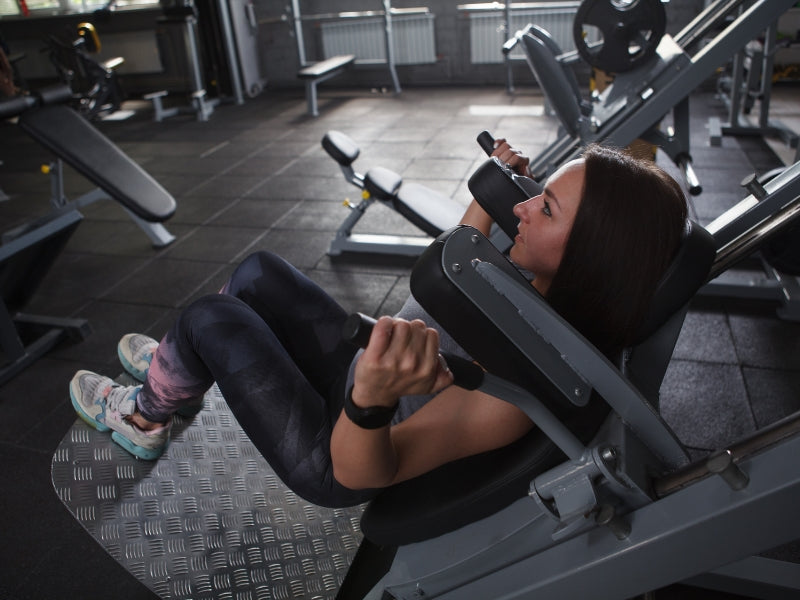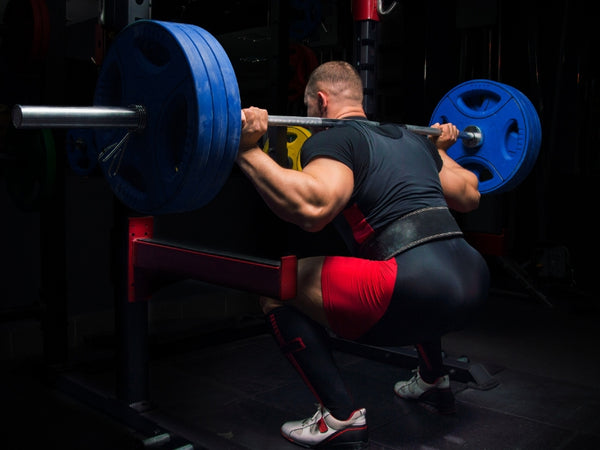Hack squats are widely considered one of the most effective leg exercises that you can incorporate into your leg routine.
Just like an ordinary squat, it is a compound exercise that targets a wide variety of muscles in your legs. Everything from your glutes and hamstrings to your quadriceps, and even your calves as well.
But as hack squats are performed using a machine they allow you to focus on each rep and grind out those few extra important reps.
However, not all gyms have hack squat machines, and you probably don't have one at home either. Or perhaps your gym is so busy that you have no chance of using it.
So it is a good idea to have alternative hack squat exercises ready to go if you need a quick substitute to keep your workout intensity going.
Let's get to it and look at the seven best hack squat alternatives for you.
What is a Hack Squat?

For those of you who don't know, the hack squat is a special type of squat that uses a machine to load the weight onto your shoulders with shoulder pads. These shoulder pads move along a set rail and have weight horns which allow you to load weight plates onto the machine.
There is a wide footplate so you can get a strong base and your back will be pressed against a backrest for added support. The rail which guides the shoulder pads is normally positioned at a 45° angle.
When you do a hack squat, you slowly push through your heels and use your legs to push your body and the weighted sled upwards, hold it for a second or two, and then slowly go back down to the starting position.
7 Best Alternatives to Hack Squats
Now that you know what the hack squat is, you might be looking for some alternatives, whether it's because you just don't like the hack squat machine itself, or because your gym or your home doesn't have one.
Let's take a look at the seven best hack squat alternatives.
Leg Press
One machine that every gym almost certainly has is a leg press machine. This is very similar to the hack squat machine, with two key differences.
First, instead of looking away from the machine at a 45° angle, such as on the hack squat, you are looking at the machine at a 45° angle.
Second, instead of your back and shoulders pressing against a moving weight sled and your feet remaining stationary, the leg press is the opposite.
Here, you sit against a stationary seat, and the platform that you hold your feet against contains the sled that you push with your feet.
Many people like the leg press machine because it tends to put a little bit less strain on the knee joint, and what's also nice is that depending on how you place your feet, you can also adjust exactly which muscles are targeted to the most.
Although you might be able to lift a whole lot of weight on a leg press machine due to its mechanics, it is important to practice correct form with each rep.
Belt Squat
The next best hack squat alternative is known as the belt squat. The belt squat is characterized by the use of a harness or a weighted belt.
Here, instead of having weight on your shoulders that you push upwards, like with a hack squat, you suspend a use a specialist machine to add resistance to the belt or you can use a weight plate, dumbbell, or kettlebell.
This is a good exercise for targeting your hamstrings, quadriceps, and glutes.
What's cool is that the belt squat is an exercise that you can adjust to match your current weight preferences and fitness level. With that being said, you do require a special weight belt for this exercise.
Barbell Squat

As you might expect, the barbell squat is a great alternative to the hack squat and is one of the most common leg exercises performed in any gym.
Just in case you have never stepped foot in a gym before, barbell squats involve holding a barbell across the top of the shoulders, with weight plates attached to each side, and then squatting down as low as you can go, holding the position, and then pushing back up.
Your feet should be shoulder-width apart during this exercise, and your movement should be very slow and controlled. Ensure that your knees stay firmly planted over your toes, that your core is engaged, and your back is straight.
This is a great type of squat to work out your quadriceps, your hamstrings, and your glutes. Something that many people love about the barbell squat is that it's very versatile, because it works out many muscle groups at the same time.
There are also many different types of barbell squats that you can do besides the originals, including Bulgarian squats, sumo squats and heels heel-raised squats to list just a few. It's all about targeting slightly different muscle groups.
Related: Guide to Smith Machine Squats.
Sissy Squat
Next on the list is the sissy squat, and although it might sound funny, it's actually one of the more challenging hack squat alternatives on the list today.
If you're looking to target your quadriceps above all else, along with your rectus femoris muscle, which is at the front of your thigh, then the sissy squat is a top exercise for you to do.
To do a sissy squat, you need to start by standing with your feet at shoulder width, lean backwards, and lower yourself down while keeping the knees and ankles perfectly aligned.
It's one of the harder exercises out there because you need a whole lot of control, balance, and even core power too.
If you have an advanced or intermediate fitness level, then it may be a good exercise to try, although if you are just a beginner, we wouldn't start with it.
That said, it's also a great exercise to help improve your overall knee stability and range of motion, particularly when compared to regular hack squats.
Some gyms will have a Sissy squat stand that helps hold your ankles in place and make balancing slightly easier.
Related: Sissy squats are also a great alternative to leg extensions.
Kettlebell Goblet Squat
Fifth on our list is the kettlebell Goblet squat. Although it can be performed using a dumbbell or handle on a cable machine, kettlebells tend to be a little easier to hold a forgiving on your wrists.
For this exercise, all you do is hold the kettlebell or dumbbell close to your chest, squat down as usually would, and then return to your starting position.
It’s a great exercise to do because if you lean forward just a little bit, you'll end up engaging your core muscles quite a bit, while also targeting your hamstrings, quadriceps, and glute muscles.
Many people also prefer the goblet squat because it can help increase your overall upper body activation, enhance core stability, and can also help to improve your overall posture.
It's also a great exercise because you can use a medicine ball, a sandbag, and you can increase or decrease the weight as you see fit.
Related Exercise: Smith Machine Hip Thrust Guide
Landmine Squat
Landmine squats are another great alternative and one of the more interesting ones on the list today. Here, you need what is known as a landmine attachment which you should be able to find in most commercial gyms.
This is a special type of workout equipment that gets placed in the corner of a room, and one end of the barbell then gets wedged into it.
You then hold the other end of the barbell with your hands, start in a squatting position, and then drive upwards, making sure to engage your glutes, hamstrings, and quadriceps.
This is a great type of squat to do for your legs if you have back problems, because it takes some of the pressure and stress away from your lower back, especially when compared to hack squats.
What's also ideal about this type of squat is that it emphasizes unilateral training, which is great for improving your overall stability and correcting any muscle imbalances that you may have.
If you can't find a landmine attachment, you can place the end of a barbell in the corner of a room, but it can damage the wall. But a neat little trick is to cut open a tennis ball a put it over the end of the barbell to protect the walls from getting damaged.
Safety Bar Squats
Although back squats are a great exercise, as an alternative to hack squats, safety bar squats mimic the body position slightly better. But not all gyms will have a safety squat bar.
This is a special type of bar that has handles which come over the front of your shoulders which you can hold onto. As a result, the weight of the bar is shifted back slightly which forces you to keep your back in a slightly more upright position when performing each rep.
Related: How much does a safety squat bar weigh?
Split Squat
Last but not least we have the split squat, also known as a stationary lunge. We already mentioned unilateral training above, and this is another great exercise on that front.
This is because you stand with one foot forward and the other foot behind you, and then lower your body by bending at the knees until your rear knee is almost touching the ground, but don't let it touch the ground. You then push through the front foot to return to the original standing position.
Just like the other squats on our list today, this one is also great for targeting the hamstrings, quadriceps, and glutes, it helps engage your core, and it also helps increase your overall range of motion.
Choosing the Right Exercise for You
Let's just go through some quick tips on choosing the right alternative exercises for you, as well as some tips to perform these exercises properly.
- When choosing from these exercises, always choose the one that targets the specific muscle groups you're looking to exercise.
- Next, make sure that you choose one that is in line with your fitness level and the amount of weight you can lift. There's no point in lifting too much and injuring yourself.
- Always ensure that you maintain proper form, because squats can be dangerous for your knees and back if not properly executed.
- Your spine needs to stay neutral throughout the exercise, and if you are rounding or arching your back, you are leaving yourself open to injury.
- To ensure that you don't cause yourself any leg injuries, your knees should always stay in line with the tops of your toes.
- At the same time, to help stabilize yourself and prevent injuries, engaging your core while squatting is essential.
- Breathing matters as well, so always exhale while you are pushing or exerting yourself, and inhale during the relaxation phase.
- Keep in mind that when doing any kind of squat, a narrower stance will focus more on your quadriceps while a wider stance will focus more on your hamstrings and glutes.
Related: What muscles do burpees work?
Final Thoughts
Being able to adapt and substitute exercises for comparable movements is key to maintaining a good workout intensity. This will help you maintain a high workout intensity and keep you moving towards your training goals.
As you can see, there are plenty of other hack squat-type exercises out there that target your hamstrings, quadriceps, glutes, and calves equally as well, so give them a try.





